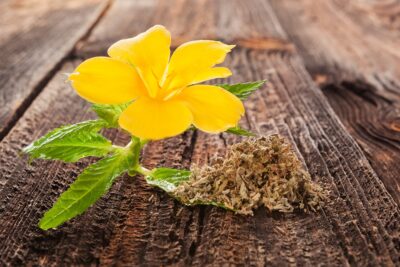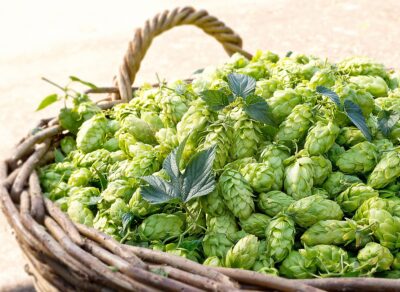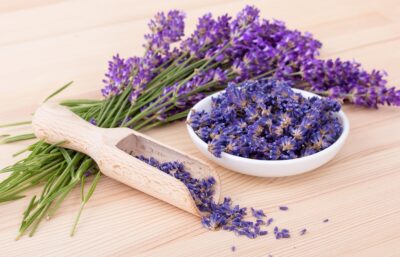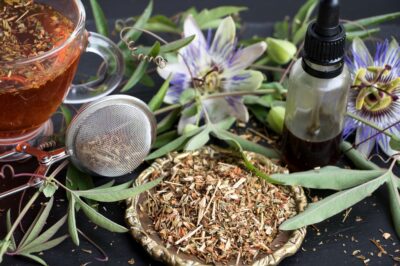In this page you’ll find the most useful psychoactive herbs for sleep. Psychoactive herbs are plants with the power to affect one’s state of consciousness.
The main actions that these sleep herbs can perform include: Promotion of sleep and sleepiness, tranquilizers, relaxants, sedatives, pain relievers. They may be useful for treating insomnia.
Warning: Consult with your physician before using any of the below plants.
Blue Lotus (Nymphaea caerulea)
Nymphaea is the water lily, from the Latin nympha, (“bride, nymph.”)
The Nymphaea caerulea in particular produces a fragrant and euphoric smoking experience.
This flower was sacred to the Ancient Egyptians who used it to induce an altered state of consciousness that is dreamy, relaxing, and sedating.
California Poppy (Eschscholzia californica)
The dried aerial parts of the plant contain alkaloids and flavone glycosides, which produce nervine, hypnotic, antispasmodic, and anodyne effects.
This herb can be used as a sedative, especially for children or people suffering from painful spasms.
When smoked, the California Poppy is said to produce smooth smoke that helps decrease anxiety and relieve pain.
Catnip (Nepeta cataria)
The leaves and flowering tops contain volatile oils, iridoids and tannins, which produce carminative, antispasmodic, diaphoretic, nervine, and astringent actions.
This herb can be used as a light nervine sedative.
When smoked, Catnip is said to produce a relaxing, soothing, and giggly experience.
Coltsfoot (Tussilago farfara)
The dried flowers and leaves contain flavonoids, mucilage, inulin, alkaloids, and tannins, which produce expectorant, antitussive, antispasmodic, demulcent, anticatarrhal, and diuretic actions.
Its diuretic properties limit its usefulness as a sleep herb, but it can be sometimes be helpful when sleep is interrupted by cough.
Avoid using Coltsfoot for longer than 4-6 weeks per year.
When smoked, Coltsfoot is an excellent tobacco alternative for people suffering from chronic cough or other respiratory issues. It is an ultra smooth smoking herb with a neutral flavor.
Damiana (Turnera diffusa)
Damiana contains resins, which produce nervine relaxant and antispasmodic actions.
When smoked, it is said to produce a happy high, smooth, and earthy, a great alternative to Cannabis with mood elevating, relaxing, and anxiety-relieving qualities.

German Chamomile (Matricaria chamomilla)
The flower head contains sesquiterpenes, lactones, and flavoid glycosides, which produce nervine, antispasmodic, carminative, anti-inflammatory, antimicrobial, bitter, and vulnerary actions.
As a relaxing nervine, it can be used for insomnia, anxiety, tension and stress. Since it’s antispasmodic, it may also ease muscle cramps.
Greater Celandine (Chelidonium majus)
The aerial parts and roots contains alkaloids with strong bitter, emmenagogue, mild analgesic, cholagogic, antimicrobial, oncostatic, and central nervous system sedative.
A tranquil smoking herb that contains 8 of the same alkaloids as the opium poppy, it is said to be beneficial for muscle relaxation, relieve pain, reduce anxiety, promote detoxification, and stimulate immune system. Can aid in quitting cannabis. (If you want to quit cannabis because it interferes with your dream recall, then you can also try switching to cannabis oil.)
Hops (Humulus lupulus)
The inflorescence (strobile) contains volatile oils, flavonoids, oleoresin, estrogenic substances, tannins, and lipids, which produce sedative, hypnotic, antimicrobial, antispasmodic, and astringent actions.
The plant relaxes the central nervous system and is used extensively to treat insomnia. It may also ease tension, anxiety, worry and restlessness.
In combination with Valerian, Hops may improve sleep disturbances.

Hops (Humulus lupulus)
Kava Kava (Piper methysticum)
The rhizome contains kavalactones and chalcones, which produce relaxing nervine, hypnotic, antispasmodic, local anesthetic, and antifungal actions.
Kava may be used to treat anxiety and depression without interfering with alertness or impairing reaction time. It seems to improve concentration, making it a nootropic.
The plant may also help with mild insomnia, especially when it results from muscle spasms, tension, or oral pain.
Lavender (Lavandula angustifolia)
The flowers contain volatile oils, coumarins, triterpenes and flavonoids, with carminative, antispasmodic, relaxing nervine, antidepressant, rubefacient, emmenagogue, and hypotensive actions.
Lavender is often used to relieve stress-related headaches, depression, as a nervous system tonic, and to promote natural sleep.

Lavender – Lavandula angustifolia
Lemon Balm (Melissa officinalis)
The aerial parts contain volatile oils, flavonoids, polyphenolics, and triterpenic acids, which produce carminative, nervine, antispasmodic, antidepressant, diaphoretic, antimicrobial, and hepatic actions.
Lemon balm may be used for neuralgia, anxiety-induced palpitations, insomnia, and migraine associated with tension.
The plant also contains harmine, which is a central nervous system stimulant that is entheogenic at high doses.
Linden (Tilia platyphyllos)
The dried flower contains volatile oils, flavonoids, mucilage, phenolic acids, and tannins, which produce nervine, antispasmodic, hypotensive, diaphoretic, diuretic, anti-inflammatory, and astringent actions.
Linden is a relaxing remedy for use in nervous tension.
Motherwort (Leonurus cardiaca)
The aerial parts contain iridoids, labdane diterpenes, flavonoids, caffeic acid, alkaloids, tannins, and volatile oil, which produce nervine, emmenagogue, antispasmodic, hepatic, cardiotonic, and hypotensive actions.
May be useful for insomnia.
Mullein (Verbascum thapsus)
The dried leaves and flowers contain flavonoids, mucilage, saponins, tannins, and volatile oil, which produce expectorant, demulcent, anti-inflammatory, antispasmodic, and vulnerary actions.
Ingesting Mullein as part of your smoking mix or tea may help with a number of respiratory conditions such as asthma, a tight chest, moisture in the lungs, wet and unproductive cough, as well as allergies.
Mulungu (Erythrina mulungu)
Mulungu is a strong sedative effective for insomnia and anxiety. It is said to be one of the most powerful naturally occurring tranquilizers.
Pasqueflower (Pulsatilla vulgaris)
The aerial parts contain lactones, protoanemonin, saponins, flavonoids, anemone camphor, tannins, and volatile oil, which produce nervine, antispasmodic, and antibacterial actions.
Pasque Flower is a relaxing nervine which may be useful for problems combining spasm in the reproductive system with overall nervous tension. It may help alleviate tension and headaches, and is appropriate for insomnia and general nervous overactivity.
Passionflower (Passiflora incarnata)
The whole plant contains alkaloids and flavonoids, which produce nervine, hypnotic, antispasmodic, anodyne, and hypotensive actions.
Passiflora is used for its sedative and soothing properties and to relieve insomnia. It has a depressive effect on the central nervous system. It’s the herb of choice for intransigent insomnia, easing the transition into restful sleep without causing any next-day hangover. It can be effective for nerve pain.
Passionflower also contains harmaline, which has entheogenic properties, and harmine which is a central nervous stimulant that is entheogenic at high doses.

Passionflower – Passiflora incarnata
Skullcap (Scutellaria lateriflora)
The aerial parts contain flavonoids, iridoids, volatile oil, and tannins, which produce nervine tonic, antispasmodic, and hypotensive actions.
Skullcap sooths nervous tension while renewing and revivifying the central nervous system.
This plant is also anxiolytic and may be suitable to treat insomnia, nightmares, and restless sleep.
St. John’s Wort (Hypericum perforatum)
The aerial parts contain volatile oils, hypericin, hyperforin, catechins, proanthocyanidins, and flavonoids, which produce anti-inflammatory, astringent, vulnerary, nervine, and antimicrobial actions.
St. John’s Wort has sedative and pain-relieving effects. It can help with mild depression, anxiety, tension and neuralgic pain. It is restorative and neuroprotective, helping to reverse long-term nervous exhaustion and lowered mood.
Since St. John’s Wort is said to simultaneously boost serotonin, dopamine, and norepinephrine levels and it may also be a MAOI, it may also serve as a dream herb.
Valerian (Valeriana officinalis)
The rhizome, stolon, and root contain essential oil and iridoids, which produce nervine, hypnotic, antispasmodic, carminative, hypotensive, and emmenagogue actions.
Valerian’s main indications are tension, anxiety, nervous sleeplessness, and bodily symptoms of tension, such as muscle cramping. It may also serve as a mild pain reliever. A useful herbal sleep aid, Valerian helps promote normal sleep without suppressing REM sleep.
Vervain (Verbena officinalis)
The aerial parts contain iridoids, essential oil, and mucilage, which produce nervine tonic, sedative, antispasmodic, diaphoretic, hypotensive, galactagogue, and hepatic actions.
Vervain is a gentle anxiolytic, which may be helpful for easing depression and melancholia.
White Willow (Salix alba)
The bark contains salicylic acid, which produces analgesic, anti-inflammatory, and tonic actions.
White Willow is the original aspirin, effective for pain reduction, supports joint health, and relieves occasional headaches.
Wild Lettuce (Lactuca virosa)
The dried leaves contain lactucin, flavonoids, and coumarins, which produce nervine, anodyne, hypnotic, and antispasmodic actions.
Wild Lettuce is a valuable remedy for insomnia and restlessness.


